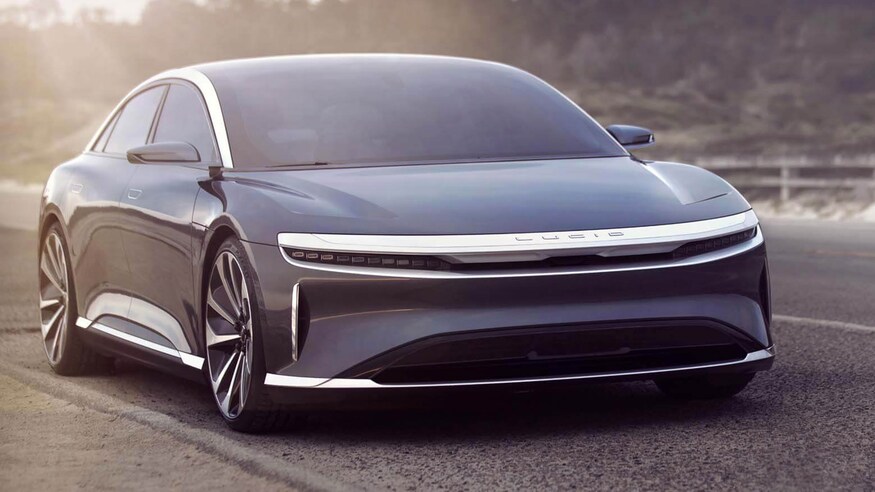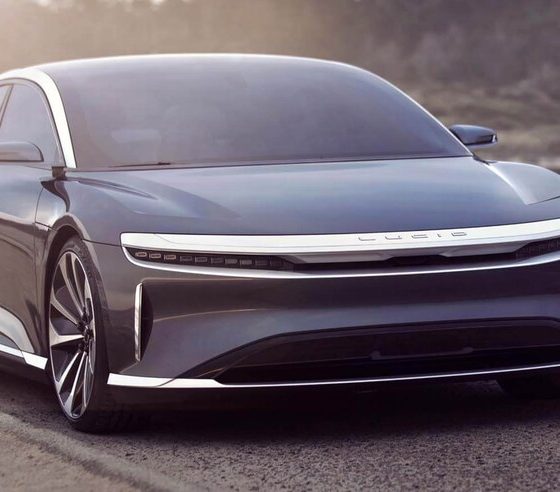

News
Lucid Air looks to dethrone Tesla Model S and Porsche Taycan with killer aerodynamics
It appears that the upcoming Lucid Air is poised to enter the market with a trump card against the kings of the premium electric sedan market today: the Tesla Model S and the Porsche Taycan. While the Model S boasts a drag coefficient (Cd) of 0.23, and the Porsche Taycan stands with an impressive Cd of 0.22, tests of the Lucid Air at the Windshear facility in North Carolina have determined that the upcoming premium electric sedan has an industry-leading Cd of only 0.21.
The findings were announced by the electric car maker on Tuesday, with Peter Rawlinson, CEO and CTO of Lucid Motors stating that the company has been intensively focused on optimizing the Air’s aerodynamics. This should help the vehicle achieve its target electric range of 400 miles per charge, which should place it right on the level of the Tesla Model S’s EPA range and far above that of the Porsche Taycan.
“Aerodynamic efficiency plays a key role in achieving world-beating range and performance and is particularly valuable to an EV in that it provides ‘smart range’ independent of battery pack size. So naturally, we intensively focused upon aerodynamics throughout the Lucid Air’s development. Our aero team worked seamlessly with design and engineering counterparts, establishing aero efficiency as a core tenet of Lucid Air from its very inception, enabling us to achieve this new standard,” Rawlinson remarked.
Aerodynamics matter much in vehicles, and it is even more important in electric cars. EVs rely a lot on their range, and thus, the greater the aerodynamics, the less automakers need to rely on battery size to achieve a car’s target range. Any electric car could boast a 400-mile range after all, but only those with stellar battery cell chemistry, software, and aerodynamics can draw such a distance from a regular-sized battery pack.
Fortunately, the company has stated that its Air beta prototypes have been achieving more than 400 miles of highway range regularly during their real-world tests. This bodes well for the electric sedan, as its range could prove to be a key selling point against established vehicles like the Tesla Model S and newer rivals from veteran auto like the Porsche Taycan.
The final version of the Air has not been fully revealed by Lucid yet, though the company has stated that the vehicle has multiple functional elements that could guide the air through and around the car. The front of the sedan, for example, has a “vortex-generating air intake system,” which distributes cool air across heat exchanges with a smaller opening.
The Lucid Air’s production version is expected to be unveiled this September 9, 2020, with manufacturing set to begin by the end of the year. Pricing for the production version of the Air has not been announced, though expectations are high that its top-tier variant will all its options, would cost around $100,000.

News
Tesla FSD fleet is nearing 7 billion total miles, including 2.5 billion city miles
As can be seen on Tesla’s official FSD webpage, vehicles equipped with the system have now navigated over 6.99 billion miles.

Tesla’s Full Self-Driving (Supervised) fleet is closing in on almost 7 billion total miles driven, as per data posted by the company on its official FSD webpage.
These figures hint at the massive scale of data fueling Tesla’s rapid FSD improvements, which have been quite notable as of late.
FSD mileage milestones
As can be seen on Tesla’s official FSD webpage, vehicles equipped with the system have now navigated over 6.99 billion miles. Tesla owner and avid FSD tester Whole Mars Catalog also shared a screenshot indicating that from the nearly 7 billion miles traveled by the FSD fleet, more than 2.5 billion miles were driven inside cities.
City miles are particularly valuable for complex urban scenarios like unprotected turns, pedestrian interactions, and traffic lights. This is also the difference-maker for FSD, as only complex solutions, such as Waymo’s self-driving taxis, operate similarly on inner-city streets. And even then, incidents such as the San Francisco blackouts have proven challenging for sensor-rich vehicles like Waymos.
Tesla’s data edge
Tesla has a number of advantages in the autonomous vehicle sector, one of which is the size of its fleet and the number of vehicles training FSD on real-world roads. Tesla’s nearly 7 billion FSD miles then allow the company to roll out updates that make its vehicles behave like they are being driven by experienced drivers, even if they are operating on their own.
So notable are Tesla’s improvements to FSD that NVIDIA Director of Robotics Jim Fan, after experiencing FSD v14, noted that the system is the first AI that passes what he described as a “Physical Turing Test.”
“Despite knowing exactly how robot learning works, I still find it magical watching the steering wheel turn by itself. First it feels surreal, next it becomes routine. Then, like the smartphone, taking it away actively hurts. This is how humanity gets rewired and glued to god-like technologies,” Fan wrote in a post on X.
News
Tesla starts showing how FSD will change lives in Europe
Local officials tested the system on narrow country roads and were impressed by FSD’s smooth, human-like driving, with some calling the service a game-changer for everyday life in areas that are far from urban centers.

Tesla has launched Europe’s first public shuttle service using Full Self-Driving (Supervised) in the rural Eifelkreis Bitburg-Prüm region of Germany, demonstrating how the technology can restore independence and mobility for people who struggle with limited transport options.
Local officials tested the system on narrow country roads and were impressed by FSD’s smooth, human-like driving, with some calling the service a game-changer for everyday life in areas that are far from urban centers.
Officials see real impact on rural residents
Arzfeld Mayor Johannes Kuhl and District Administrator Andreas Kruppert personally tested the Tesla shuttle service. This allowed them to see just how well FSD navigated winding lanes and rural roads confidently. Kruppert said, “Autonomous driving sounds like science fiction to many, but we simply see here that it works totally well in rural regions too.” Kuhl, for his part, also noted that FSD “feels like a very experienced driver.”
The pilot complements the area’s “Citizen Bus” program, which provides on-demand rides for elderly residents who can no longer drive themselves. Tesla Europe shared a video of a demonstration of the service, highlighting how FSD gives people their freedom back, even in places where public transport is not as prevalent.
What the Ministry for Economic Affairs and Transport says
Rhineland-Palatinate’s Minister Daniela Schmitt supported the project, praising the collaboration that made this “first of its kind in Europe” possible. As per the ministry, the rural rollout for the service shows FSD’s potential beyond major cities, and it delivers tangible benefits like grocery runs, doctor visits, and social connections for isolated residents.
“Reliable and flexible mobility is especially vital in rural areas. With the launch of a shuttle service using self-driving vehicles (FSD supervised) by Tesla in the Eifelkreis Bitburg-Prüm, an innovative pilot project is now getting underway that complements local community bus services. It is the first project of its kind in Europe.
“The result is a real gain for rural mobility: greater accessibility, more flexibility and tangible benefits for everyday life. A strong signal for innovation, cooperation and future-oriented mobility beyond urban centers,” the ministry wrote in a LinkedIn post.
News
Tesla China quietly posts Robotaxi-related job listing
Tesla China is currently seeking a Low Voltage Electrical Engineer to work on circuit board design for the company’s autonomous vehicles.

Tesla has posted a new job listing in Shanghai explicitly tied to its Robotaxi program, fueling speculation that the company is preparing to launch its dedicated autonomous ride-hailing service in China.
As noted in the listing, Tesla China is currently seeking a Low Voltage Electrical Engineer to work on circuit board design for the company’s autonomous vehicles.
Robotaxi-specific role
The listing, which was shared on social media platform X by industry watcher @tslaming, suggested that Tesla China is looking to fill the role urgently. The job listing itself specifically mentions that the person hired for the role will be working on the Low Voltage Hardware team, which would design the circuit boards that would serve as the nervous system of the Robotaxi.
Key tasks for the role, as indicated in the job listing, include collaboration with PCB layout, firmware, mechanical, program management, and validation teams, among other responsibilities. The role is based in Shanghai.
China Robotaxi launch
China represents a massive potential market for robotaxis, with its dense urban centers and supportive policies in select cities. Tesla has limited permission to roll out FSD in the country, though despite this, its vehicles have been hailed as among the best in the market when it comes to autonomous features. So far, at least, it appears that China supports Tesla’s FSD and Robotaxi rollout.
This was hinted at in November, when Tesla brought the Cybercab to the 8th China International Import Expo (CIIE) in Shanghai, marking the first time that the autonomous two-seater was brought to the Asia-Pacific region. The vehicle, despite not having a release date in China, received a significant amount of interest among the event’s attendees.








